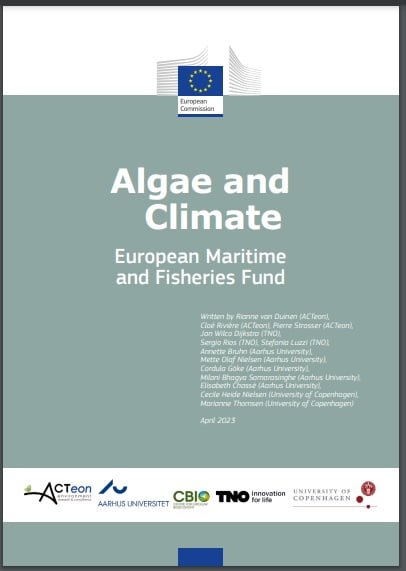
The European Commission’s “European Green Deal” aims to transform the European Union (EU) into the world’s first climate-neutral region. In this context, more attention has been given to the role of marine ecosystems and the blue economy.
A report prepared for the European Commission outlines the potential of 10 microalgae and macroalgae production systems that could contribute to the animal feed needs within the European Union.
The document summarizes the current state of knowledge in terms of biomass, nutritional composition, costs, and greenhouse gas emissions. The report also compares the production systems with terrestrial plant crops that share similar properties.
Finally, the document assesses the EU’s potential for algae production that could be sustained with current CO2 emissions from point sources and contribute to satisfying animal feed needs.
Microalgae and macroalgae with the highest potential
The study highlights the potential of 10 species of microalgae and macroalgae for the development of this industry in the European Union.
| Macroalgae / Microalgae | Species | Cultivation methods |
| Coastal | Saccharina latissima | Rope system |
| | Alaria esculenta | Rope system |
| | Palmaria palmata | Rope system, pond / tanks / raceways |
| | Asparagopsis sp. | Rope system |
| | Ulva sp. | Rope system, pond |
| Land-based | Spirulina | Pond |
| | Chlorella sp. | Photobioreactor |
| | Haematococcus pluvialis | Photobioreactor |
| | Nannochloropsis sp. | Photobioreactor |
| | Asparagopsis sp. | Photobioreactor |
What can algae provide?
To meet global food demand, algae offer an alternative source of food and inputs due to their protein, carbohydrate, and lipid content.
The study describes that scientific evidence reports significant variations in composition among algae species. “Nutritional values also vary significantly among studies employing the same production system, reflecting variations in cultivation conditions, seasons, and growth states.”
Microalgae production systems have the highest potential for food applications due to their high protein production. Microalgae are also a promising sustainable source of lipids, omega-3 fatty acids, and carbohydrates.
On the other hand, macroalgae also represent an important source of protein, functional carbohydrates, minerals, and bioactive compounds, even though their nutritional production is lower compared to microalgae.
What are the production costs of algae?
The report states that on average, microalgae cultivation systems (EUR 27/kg dry weight) tend to have higher total costs than macroalgae (EUR 14/kg dry weight) due to the higher capital investment associated with establishing the bioreactor, as well as labor and electricity consumption.
Moreover, due to the high water content of algae, drying methods must be used after harvest. Depending on the harvesting method, drying techniques, and energy requirements, drying costs can be significant. On average, drying costs for macroalgae (EUR 0.3/kg dry weight) are higher than for microalgae (EUR 0.9/kg dry weight).
Greenhouse gas emissions from algae cultivation
Algae production has positive effects on greenhouse gas emissions. During the growth phase, algae remove CO2 from the atmosphere and convert it into biomass.
However, algae cultivation operations also contribute to greenhouse gas emissions, in activities related to direct operations, input and equipment purchases, and the use of algae-based products.
Regarding CO2 fixation, the study results show that open systems (raceways-ponds) have relatively low fixation efficiency (30%) compared to closed systems (60%). Closed systems allow for a higher efficiency in utilizing supplied CO2.
Do microalgae used in animal feed have potential?
“The analysis shows that additional income from carbon credit sales is not an effective solution to economically make algae production for animal feed viable: income from credit sales will always be marginal, as the amount of carbon captured by algae is very low (1.8 kg CO2/kg dry weight biomass on average),” they report.
They also indicate that the price of algae for animal feed to compensate for algae production was estimated at 113 EUR/kg crude protein, a value far from competitive when compared to soybean meal, which was priced at 0.92 euros/kg in 2021.
Importance of algae in animal feed
The use of algae in animal diets can help reduce methane emissions from ruminants. Additionally, several of the studied macroalgae species accumulate minerals at levels exceeding the limits set by the European Food Safety Association (EFSA).
Asparagopsis taxiformis has a potent inhibitor of enteric methane formation in ruminants. Studies report reductions of 30% in dairy cows and 50 to 70% in beef cattle, without negative effects on animal performance.
On the other hand, Chlorella sp., Nannochloropsis sp., and Spirulina sp. can be used in the diets of dairy cows, pigs, and chickens up to a certain percentage without negative effects on food assimilation or milk production.
Research gaps
The study identified the following research needs:
- Additional species of macro and microalgae, as well as additional terrestrial production systems;
- Post-harvest processing to support the sustainable expansion of biomass production and eliminate unwanted minerals; and
- Improvement of the nutritional value (e.g., digestibility and assimilation) of cultivable algae for animals.
Reference (open access)
van Duinen, R., Rivière, C., Strosser, P., Dijkstra, J. W. Rios, S., Luzzi, S., Bruhn, A., Olaf Nielsen, M. Göke, C., Bhagya Samarasinghe, M., Chassé, E., Heide Nielsen, C., Thomsen, M., Algae and Climate, Publication Office of the European Union, 2023, doi: 10.2926/208135
Editor at the digital magazine AquaHoy. He holds a degree in Aquaculture Biology from the National University of Santa (UNS) and a Master’s degree in Science and Innovation Management from the Polytechnic University of Valencia, with postgraduate diplomas in Business Innovation and Innovation Management. He possesses extensive experience in the aquaculture and fisheries sector, having led the Fisheries Innovation Unit of the National Program for Innovation in Fisheries and Aquaculture (PNIPA). He has served as a senior consultant in technology watch, an innovation project formulator and advisor, and a lecturer at UNS. He is a member of the Peruvian College of Biologists and was recognized by the World Aquaculture Society (WAS) in 2016 for his contribution to aquaculture.
